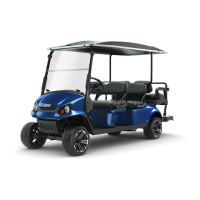38
MAINTENANCE
Tire Pressure
Maintaining correct tire inflation pressure is essential for safe vehicle operation. You can vary the inflation pressure,
within the recommended range to suit the condition of the terrain.
Tire Repair
NOTICE: Tire plug tools and plugs are available at automotive outlets. The tire does not have to be removed
from the wheel to install the tire plug.
Use a tire plug to repair small holes in the tread part of the tire. For large holes or holes/cuts in the tire sidewall, the tire
must be replaced.
1. Remove the wheel from the vehicle. See Wheel Removal on page 39.
2. Locate the leak in the tire.
a. If the tire is very low or flat, fully inflate the tire.
b. Brush soapy water over the surface of the tire. Air bubbles will be visible where the air is leaking from the
tire.
c. Mark the hole with chalk.
3. Install the plug according to the manufacturer’s instructions.
4. Install the wheel on the vehicle. See Wheel Installation on page 39.
5. Fully inflate the tire. See Tire Pressure on page 15.
Tire Replacement
Tire replacement requires a tire mounting machine, and must be done by a qualified tire center or an authorized
E-Z-GO dealer.
TIRE PRESSURE RANGE TERRAIN CONDITIONS RECOMMENDATION
22 - 26 psi (152 - 179 kPa)
hard surfaces or pavement
Inflate to higher pressure within the range; never exceed
maximum pressure indicated.
soft terrain or turf
Inflate to lower pressure within the range to reduce
potential damage to the terrain or turf.
Tools
• lug wrench, 3/4” • impact socket, 3/4”
• impact wrench • torque wrench, ft.lbs.

